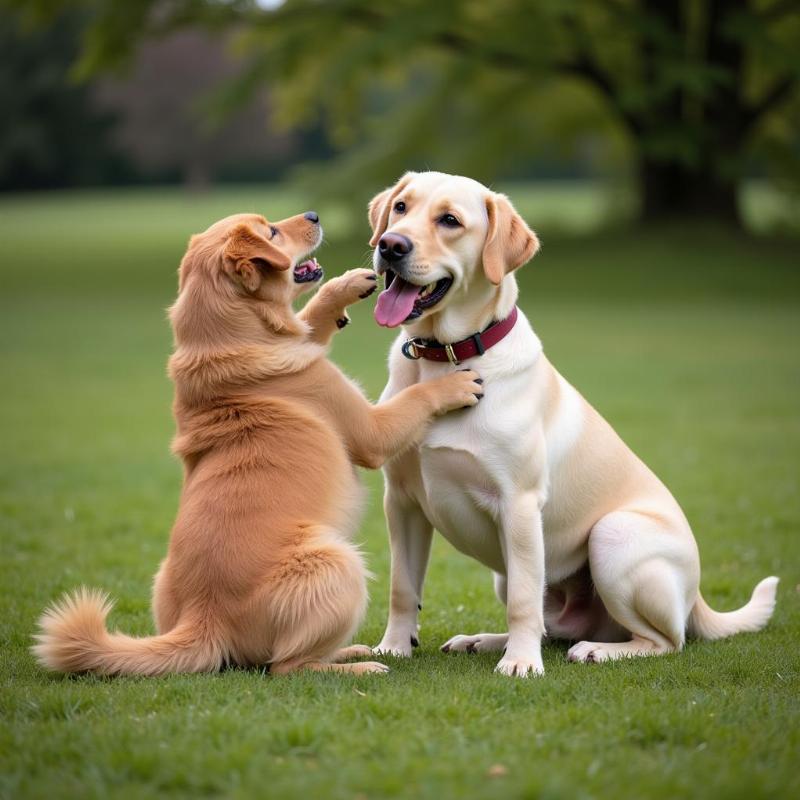Dominance, affection, playfulness, anxiety—these are just some of the reasons why your dog might sit on another dog. Understanding this seemingly odd canine behavior can give you insights into your dog’s social dynamics and overall well-being. This article explores the common motivations behind this behavior, helping you decipher what your furry friend is trying to communicate.
Decoding the Doggy Sit: Dominance or Just Cozying Up?
Dogs communicate in a language far different from our own. While we might interpret sitting on another dog as rude, for dogs, it can be a nuanced form of communication. One common interpretation is dominance. By literally placing themselves above another dog, they’re asserting their higher rank in the social hierarchy. This isn’t necessarily aggressive, but it can be a way of establishing pecking order, especially in multi-dog households. However, don’t jump to conclusions. The “dominant sit” is often misinterpreted. Other factors, like seeking comfort or warmth, also play a significant role.
Is My Dog Being a Bully? Signs of Aggression vs. Playful Interaction
 Dogs playing together
Dogs playing together
While sitting on another dog can be a sign of dominance, it’s crucial to differentiate between assertive behavior and outright aggression. If the “sitter” displays other dominant behaviors, such as resource guarding, stiff body language, staring, or growling, it might be a dominance issue. However, if the interaction involves playful bows, relaxed posture, and tail wags, the sitting could simply be part of their rough-and-tumble play. Context is key. Observe the other dog’s reaction. Are they comfortable? If they seem stressed, whimper, or try to get away, intervention may be needed. Check out our article on my dog doesn’t listen to me for tips on training and managing dog behavior.
Seeking Comfort and Security: Why My Dog Uses Other Dogs as Pillows
Just like humans, dogs seek comfort and security, sometimes in the form of a furry, four-legged pillow. This is particularly common in puppies or dogs with anxiety. The weight and warmth of another dog can be incredibly soothing, especially in stressful situations like thunderstorms or fireworks. If your dog tends to sit on other dogs during these times, it’s a sign they’re seeking reassurance. Consider providing them with a safe space, like a crate or a dog bed, along with comforting toys to help them cope. You might also want to explore resources like the green dog and cat hospital for professional advice on managing anxiety in pets.
Attention-Seeking Behavior: “Look at Me!”
Sometimes, the motivation for sitting on another dog is simply to get attention. This is particularly true for dogs who are used to being the center of attention. By sitting on another dog, they might be trying to initiate play, or they might be vying for your attention. If this seems to be the case, make sure you’re providing your dog with enough individual attention and playtime. A bored dog can find creative ways to entertain themselves, and sometimes, that involves using their canine companions as furniture.
What to Do When Your Dog Sits on Other Dogs
- Observe the Interaction: Watch for signs of stress or discomfort in the other dog.
- Consider the Context: Is it playtime, a stressful situation, or just a casual interaction?
- Intervene When Necessary: If the behavior is causing distress, gently separate the dogs.
- Provide Alternatives: Offer comforting toys or a safe space if your dog is seeking security.
- Consult a Professional: If the behavior is persistent or concerning, seek advice from a veterinarian or a certified dog trainer. You can find a helpful meloxicam for dogs dosage chart pdf on our website for guidance on safe medication administration.
Conclusion
Understanding why your dog sits on other dogs involves considering a range of factors, from dominance and playfulness to anxiety and attention-seeking behavior. By carefully observing their interactions and considering the context, you can gain valuable insights into your dog’s social dynamics and ensure a harmonious environment for all your furry companions.
FAQ
- Why does my dog sit on my other dog’s head? This could be a dominance display, but more often, it’s just a clumsy attempt at closeness or play.
- Is it dangerous if my dog sits on my other dog? It can be if the “sitter” is much larger and the other dog is uncomfortable. Monitor their interactions closely.
- Should I always stop my dog from sitting on other dogs? Not necessarily. If both dogs are comfortable, it’s often harmless.
- How can I tell if my dog is being dominant or just playful? Look for accompanying body language cues like growling, stiff posture, or relaxed tail wags.
- What if my dog gets aggressive when sitting on other dogs? Consult with a professional dog trainer or behaviorist for guidance.
- My dog sits on other dogs at the dog park. What should I do? Keep a close eye on the interaction. If the other dog seems uncomfortable, call your dog away.
- My puppy sits on my older dog all the time. Is that normal? Puppies often seek comfort and warmth from older dogs, so this behavior is usually normal.
Beautdogs.us is your one-stop resource for all things dog-related in the USA. We offer expert advice on dog breeds, care, training, and products. Whether you’re a seasoned dog owner or just starting your journey with a furry friend, Beautdogs.us is here to help. Contact us at [email protected] or +1 501-555-7529 for more information.